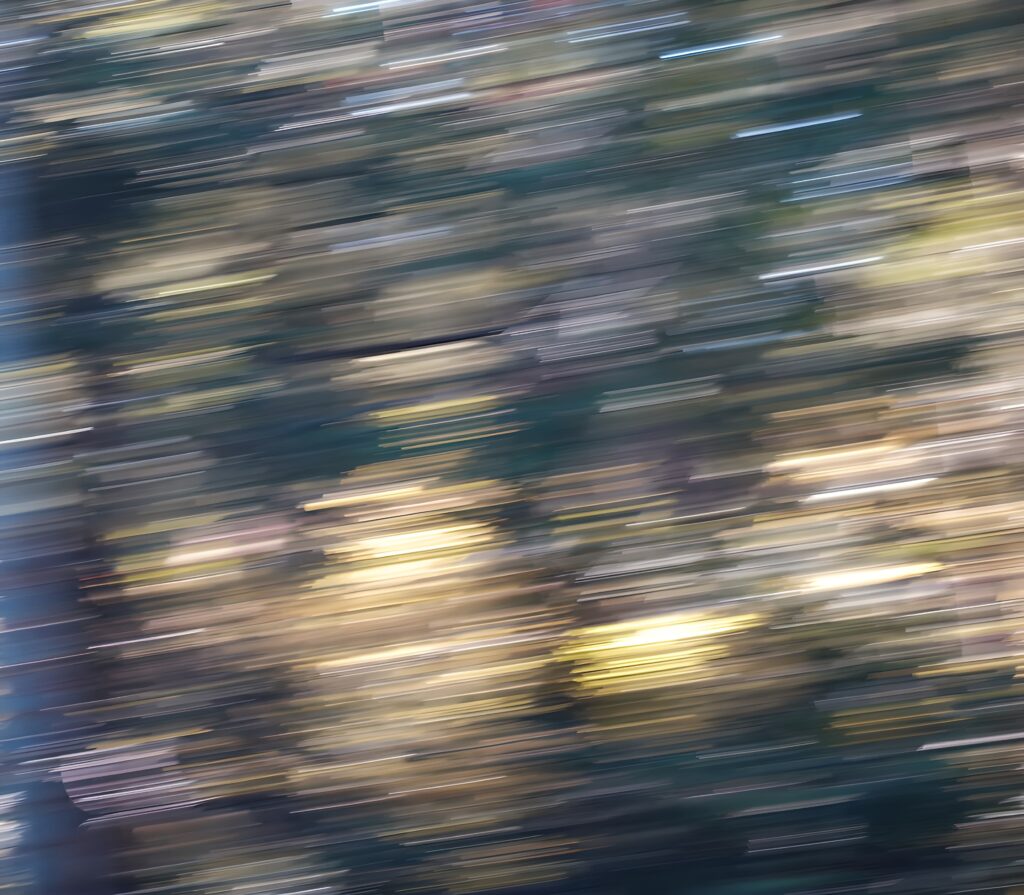1. Visual Analysis
This image is a dance of motion, light, and abstraction. The deliberate blur transforms the scene into something both dynamic and ethereal, inviting the viewer into a space where detail dissolves and only essence remains.
- Composition: The sweeping motion creates diagonal lines that dominate the frame, pulling the eye horizontally across the image. These lines suggest speed and flow, creating an underlying rhythm.
- Color: A harmonious palette of earthy greens, deep blues, and golden yellows creates a calming balance. The interplay of cool and warm tones mimics light filtering through nature—perhaps sunlight gliding through a dense forest canopy.
- Texture: The blurred texture replaces fine detail with softness, allowing for a painterly effect. The abstraction lends itself to interpretation, where the image becomes an expression of light rather than a literal representation.
- Motion: This photograph demonstrates intentional camera movement (ICM), where controlled blur transforms an ordinary scene into an exploration of light and time.
2. Philosophical Reflection
This image is an ode to impermanence and motion—core tenets of Zen philosophy. Life, much like the blurred lines captured here, is never static. It is always in motion, always shifting, always fleeting. What was clear becomes indistinct; what seemed separate merges into one.
- The Flow of Time: The motion blur reminds us that time does not pause. Like the image, our moments streak by, creating beauty in their transience.
- Abstraction and Stillness: The absence of a defined subject invites stillness in the viewer. Without clear boundaries or focal points, the mind lets go of the need to understand and instead embraces the feeling of flow.
- Light as a Teacher: The golden streaks of light offer clarity within motion—symbols of insight or fleeting moments of realization. They remind us that even within chaos, there is illumination to be found.
This photograph asks us to accept the impermanence of clarity and to embrace the beauty that exists in the spaces we cannot hold still.
3. Practical Photography Insights
This image beautifully showcases the art of abstraction through motion blur, offering valuable lessons for photographers exploring creative techniques:
- Intentional Camera Movement (ICM): To achieve this effect, use a slower shutter speed (e.g., 1/10 to 1/4 of a second) and move the camera horizontally or vertically while taking the shot. Experiment with different speeds and directions to find the most harmonious results.
- Embrace Light: Soft golden light, especially during sunrise or sunset, can transform a motion-blurred image into a painterly masterpiece. Position your frame where natural light interacts with shadows to create depth.
- Color Harmony: Choose scenes with complementary colors. Cool blues paired with warm yellows and greens, as seen here, enhance the dynamic quality of the image.
- Abstract Storytelling: Let go of the need for a clear subject. Focus instead on form, color, and texture to create mood and emotion.
Tip: Use a tripod with a panning head to stabilize controlled movement or embrace handheld freedom to explore organic motion.
4. Reflections
This image reminds us of the beauty found in surrender—surrendering to motion, to imperfection, to the fleeting nature of time. Much like water flowing in a river or wind whispering through leaves, the streaks of light in this photograph embody movement as a form of stillness. In their blurred dance, there is nothing to hold onto and yet everything to feel.
In Zen, clarity often comes not from focusing harder but from releasing control. The lines here blur as life does, but instead of resisting the motion, we are invited to flow with it. To see the blur as beauty, the imperfection as completeness.
The photograph is not chaos; it is harmony—an abstraction of life itself, where everything moves and yet everything is still.

